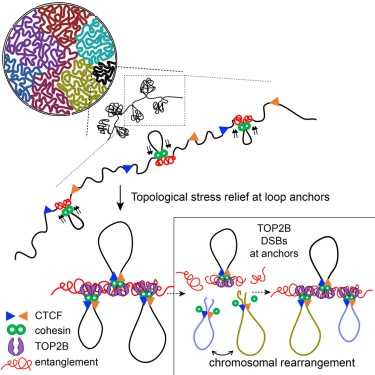- The use of fluorescence in situ hybridization (FISH) has revealed that each chromosome occupies a distinct nuclear territory and that the 3D positioning of chromosomes correlates with chromosome size and gene density.
- “Think about it, where larger chromosomes should reside, where gene poor chromosomes can be, what kind of chromosomes should occupy centre of nucleus, isn’t it feasible if active gene rich chromosomes stay close to each other?”
Well, this is exactly how nature has managed and organized everything logically and function oriented.
- Larger and more gene-poor chromosomes tend to be localized at the periphery, whereas smaller and more gene-dense chromosomes tend to be localized in the interior of the nucleus.
- In addition, the physical distance between chromosomes and the degree of chromosome intermingling correlate with chromosomal gene expression levels, that is, chromosomes with similar expression levels tend to be in greater physical proximity.
- Such transcription-dependent nonrandom positioning of chromosomes is conserved within a cell type.
Interestingly, regions of chromosome intermingling are enriched with active RNA polymerase II and various transcription factors. These regions are collectively referred to as transcription factories.
DNA associates with a number of histone and non-histone proteins, and the resulting chromatin fibre is organized into loops (for example, by forming promoter–enhancer interactions). This fibre is further condensed into domains of a few hundred kilobases in length known as topologically associated domains (TADs), which are internally enriched in cis interactions. In turn, TADs are organized into transcriptionally active and inactive (for example, heterochromatin) compartments.
Some of the heterochromatin regions are linked to the inner nuclear membrane at lamin-associated domains (LADs). High-resolution analysis of chromatin interactions within TADs revealed the presence of sites of constitutively bound CTCF (CCCTC-binding factor) that facilitate chromatin looping interactions.
Chromosome organization models have been introduced to address the mechanical coupling between nuclear morphology and gene expression. In these models, the spatial arrangement of chromosomes is viewed as a configuration of ellipsoids (the chromosome territories) packed into an ellipsoid-shaped container (the nucleus).
The shape of the container is defined by mechanical constraints, and cell type-specific configurations are determined by solving an optimization problem, where the pairwise overlap between two chromosomes is penalized on the basis of their difference in gene expression levels. The solutions to this optimization problem are configurations that link nuclear morphology with chromosome organization and gene expression.
Ref: https://www.nature.com/articles/nrm.2017.101
http://www.cell.com/cell/abstract/S0092-8674(17)30718-3

